Wednesday, April 19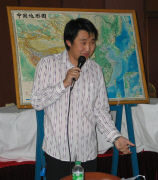 James Jin Our United Airlines flight arrived in Beijing at 5:00 pm local time (2:00 am PDT). Unfortunately, the approach to the airport was a little rough and I got airsick just before we landed. It probably didn’t help that I barely slept an hour on the plane and we had been up about 20 hours by then. I was glad to get off the plane but then got sick again in the van during the last five minutes of the ride to the hotel. So I was pretty green around the gills when we got there. But we both made it to the orientation meeting with our Program Director, James Jin Chao, who would accompany us throughout our entire 3-week trip. James wasn’t his real name, but like every tour guide in China, he had taken an English name so it would be easier to remember. Our local tour guide in Beijing was Morgan. 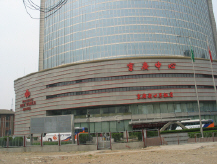 Jing Guang New World Hotel Our hotel was the 5-star Jing Guang New World, which occupies the first 23 floors of a striking 52-story fan-shaped building with a glass facade. Our room was on the 17th floor. I was looking forward to a good nights sleep but 3 hours later, I was wide awake. Fortunately, Norma was able to sleep through the night. Thursday, April 20 BeijingBreakfast was served buffet style at 7 am. In fact, all our breakfasts were buffets and always included scrambled eggs, bacon, and sausage in addition to some Chinese fare. Now and then there also were pancakes or French toast. And there was always a chef present who fried eggs or fixed omelets to order. After another orientation briefing, we boarded a bus for a sightseeing tour of Beijing. James had a system in place to keep bus seating fair. Everyday you moved one seat forward and the one who had the front seat moved to the back. The exceptions were the second seats from the front – one was for the tour guides the other for anyone who suffered from motion sickness. After my experience on the van the day before, I got the second seat the rest of our tour.  Tiananmen Square Our first stop was Tiananmen Square, the most imposing public square in the world and the site of Red Guard rallies during the Cultural Revolution and the infamous pro-democracy demonstration in 1989. It supposedly can hold up to a million people. The square is surrounded on the west by the Great Hall of the People, on the east by the National Museum of China, and on the south by Chairman Mao Zedong’s Mausoleum.  Gate of Heavenly Peace, entrance to the Forbidden City Directly north of the Square is the Tiananmen Gate of Heavenly Peace which leads to the Forbidden City. On this building is a huge portrait of Chairman Mao. 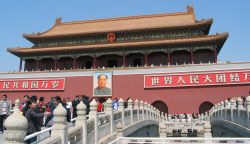 Bridge to the Gate of Heavenly Peace The Forbidden City, now called the Imperial Palace Museum, was so named because it was off limits to visitors for 500 years. Completed in 1420, it was the center of Imperial palaces for the emperors of the Ming and Qing dynasties until the last dynasty fell in 1911.  Meridian Gate
The 170-acre complex contains 800 ceremonial buildings with a reputed 9,999 rooms in which an estimated 8,000 to 10,000 people lived, including 3000 eunuchs, as well as maids and concubines. Surrounding the elegant palaces, pavilions, courtyards and gardens is a 30-foot high wall and a moat wide enough (160 ft) for naval engagements. A major renovation project was underway to repair the deteriorating buildings and some were nearly hidden behind scaffolding. The completed buildings were resplendent with their colorful and brilliant new paint and roofs. 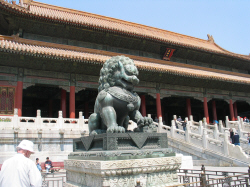 Bronze lion 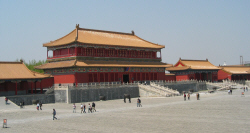 One of the Great Halls 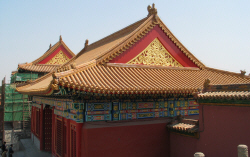 Roof and gable detail  Moat around the Forbidden City
We were taken to a restaurant outside the Forbidden City for lunch. This was the first of many Chinese lunches and dinners that we ate during the next 19 days. The meals were usually served on round tables that could seat 8 or 10 people. The entrees, always much more than we could eat, were placed on a lazy Susan in the middle of the table. The meals always included one soft drink or bottled water. Beer, about 3% alcohol, was considered a soft drink and was the choice of most people in our group. We had a couple of hours in the late afternoon to catch up on some much needed sleep before attending the traditional welcoming Peking duck dinner that evening. After dinner we attended a lecture by a University professor who gave us a rather revealing and candid talk about Chairman Mao and the Cultural Revolution. |
| Gene Maas |
| 5 Jun 2006 |
Go to page
![]() Background by
Background by ![]()